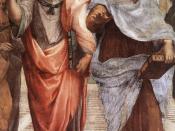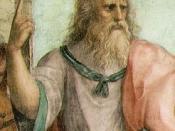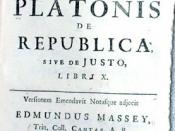Plato loves Play-dough"Who recognizes the existence of absolute beauty and is able to distinguish the idea from the objects which participate in the idea, neither putting the objects in the place of the idea nor the idea in the place of the objects" Plato begins his argument for beauty. Plato has a very plausible argument for beauty. Beauty is in "the eye of the beholder" and is merely an opinion. Also that a beautiful body is not original, and other beautiful bodies share similar qualities for one who thinks they are beautiful.
Plato starts his argument about beauty with a dialog with Glaucon. He writes "He who, having a sense of beautiful things has no sense of absolute beauty, or who if another lead him to a knowledge of that beauty is unable to follow."(14) He is dreaming and puts the copy in the place of real objects. The term "dreaming" is used as someone who is ignorant and closed minded.
Plato's argument is that there is an existence of absolute beauty and there is an idea of the object and The idea that is separate from the object.
Plato writes about copies in his writing "The Republic". Plate claims that every object in our world is a copy.(17) In general, whenever you want to explain why something is the way that it is, you point to some properties that the object has. That is, you explain what forms the object is a copy of. Things are only said to exist as they have order or structure or form. Hence, the forms are the causes of the existence of all objects as well as of their intelligibility. For example of a sun metaphor to explain how the forms in general, and the form of the Good in particular, are causes in these two ways. Just as the sun gives light which allows us to see objects, the form of the Good provides order and intelligibility to allow us to know objects. Just as the sun provides the energy for the nourishment and growth of all living things, so the form of the Good provides the order and structure which is the source of the existence of all things.
Real objects are what gives the copies its characteristics. Real objects are the true forms of these characteristics, The material world is really similar to the more real world of forms. The form of roundness, for example, is the perfect model of roundness.(16) All round material objects are merely copies or imitations of this most real form. Thus it is the forms that are ultimately real. The cave metaphor illustrates these properties of the forms well. The shadows on the wall represent material objects, while the real objects passing before the fire are the forms.(69)Plato describes the "lovers of sights and sounds" as "dreaming" that is because these people are found around the Dionysian festivals listening to every chorus.(14) But they are unable to see fineness itself and believing that the only fineness there is lies in a myriad of colors, shapes and sounds, and they mistake a likeness for the real thing. The lovers of sights and sounds have only belief and not knowledge. Thus placing them in a dreaming like state.
On the opposition, there are those who are awake. Plato describes those who are awake as one who, "having a sense of beautiful things has no sense of absolute beauty, or who, if another lead him to a knowledge of that beauty is unable to flow." (14)Plato is stating that those who are awake do not mistake a copy as a real object.(16) One who is awake understands the existence of absolute beauty andknows the existence of the ideas of real objects and characteristics.
This segment of Platos writing shows a dialog between a gentleman and Plato that he who says something is beautiful, another can say as ugly. Holy as Unholy, and heavy as light. What he writes about is that "The beautiful will in some point of view be found ugly; and the same is true for the rest (Holy)". The statement visible beautiful is merely and opinion of ones point of view and not something that can be absolute or fact. (17) But a true absolute form exists within knowledge that is true beauty or any other true characteristic that copies can be seen or heard throughout objects in our world.
Plato believe that true knowledge should relate to being or "the beautiful itself" and not to what lies between being and not-being, or visible beauty because Plato believes that visible beauty is subjective. He believes that the true form of beauty is in knowledge and is absolute. Therefore the true knowledge should relate to the true form, the absolute form itself as it lies in the knowledge.
I believe that it is completely plausible that we have an absolute idea of what beauty is. We do hear beautiful pieces of music and see beautiful objects, but Plato's point is that we are able to do so only because we have some idea of what beauty itself is. Even if hearing sounds are completely an affair of the senses, hearing that sound as beautiful is to mentally classify it as having satisfied those ideal conditions which would be specified in a definition of "beauty."Plato states that there is an absolute form of beauty, which are true objects of knowledge (16). Plato is primarily just asserting that absolute forms exist, without providing any proof. Ideas such as beauty, ugly, heavy, light, just, unjust are simply subjective ideas. Plato says "Will you be so very kind, sir, as to tell us whether, of all these beautiful things, there is one which will not be found ugly; or of the just, which will not be found unjust; or of the holy, which will not also be unholy?"(17) Plato has set up the question to that all the items are beautiful, but to what standard has Plato compared to, to say that such items are beautiful?In turn, Plato may reply to this accusation that only the awake can see that there is such absolute forms. He may say such as that the absolute forms cannot be grasped by the mind because they are so complex, only copies of them can be seen throughout the world. Plato states in his "Republic" that "The one love and embrace the subjects of knowledge, the other those of opinion? The latter are the same, as I dare say you will remember, who listened to sweet sounds and gazed upon fair colours, but would not tolerate the existence of absolute beauty." (18)In conclusion, Plato has written about copies which are characteristics of all the objects in the world. Also about real objects, they are the true absolute forms of the characteristics of the objects such as beauty, heaviness. Plato wrote about the lovers of sounds and sights to be dreaming because they can not see the existence of absolute beauty and completely denies it when lead to the knowledge. Those who are awake who see the existence of the absolute true forms and will not mistake between the copies and real forms. Plato states that visible beauty and other characteristics are merely opinions and such points of view, only the true forms are absolute. There is the objection of which Plato has not proven that such absolute knowledge exists and that he has forced his example for everything to be beautiful. Platos answer as that those who are dreaming will deny that absolute knowledge exists when lead to the idea.
Cottingham, John. "Western Philosophy: An Anthology". Blackwell Publishing,





